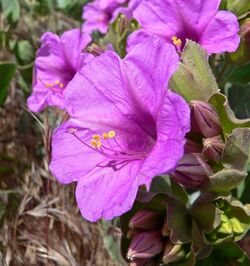Biology:Mirabilis multiflora
| Mirabilis multiflora | |
|---|---|

| |
| Scientific classification | |
| Kingdom: | Plantae |
| Clade: | Tracheophytes |
| Clade: | Angiosperms |
| Clade: | Eudicots |
| Order: | Caryophyllales |
| Family: | Nyctaginaceae |
| Genus: | Mirabilis |
| Species: | M. multiflora
|
| Binomial name | |
| Mirabilis multiflora (Torr.) A.Gray
| |
Mirabilis multiflora is a species of flowering plant in the four o'clock family known by the common name Colorado four o'clock that is native to the southwestern United States from California to Colorado and Texas , as well as far northern Mexico, where it grows in mostly dry habitat types in a number of regions.
Description
It is a perennial herb growing upright to about 80 centimetres (31 in) in maximum height. The leaves are oppositely arranged on the spreading stem branches. Each fleshy leaf has an oval or rounded blade up to 12 centimetres (4.7 in) long and is hairless or sparsely hairy. The flowers occur in leaf axils on the upper branches. Usually six flowers bloom in a bell-shaped involucre of five partly fused bracts. Each five-lobed, funnel-shaped flower is 4 to 6 centimetres (1.6 to 2.4 in) wide and magenta in color.
Uses
Among the Zuni people, the powdered root is mixed with flour, made into a bread, and used to decrease appetite.[1] An infusion of the root is taken and rubbed on the abdomen of hungry adults and children.[2] An infusion of the powdered root is taken by adults or children after overeating.[3]
Pollination
M. multiflora's reproduction is dependent on hawkmoths for pollination. Two primary pollinators are the hawkmoths Hyles lineata and Manduca quinquemaculata.[4]
References
- ↑ Camazine, Scott; Bye, Robert A. (1980). "A Study Of The Medical Ethnobotany Of The Zuni Indians of New Mexico". Journal of Ethnopharmacology 2 (365–388): 377. doi:10.1016/S0378-8741(80)81017-8. PMID 6893476.
- ↑ Stevenson, Matilda Coxe (1915). "Ethnobotany of the Zuni Indians". SI-BAE Annual Report #30: 58, 59.
- ↑ Stevenson 1915, p. 58
- ↑ Hodges, Scott A.. Some preliminary Observations on Hawkmoth Pollination of Oenothera caespitosa and Mirabilis multiflora. pp. 244–249. http://www.wmrc.edu/resources/docs/Plant-Biology/chapter21.pdf.
External links
Wikidata ☰ Q2623355 entry
 |

